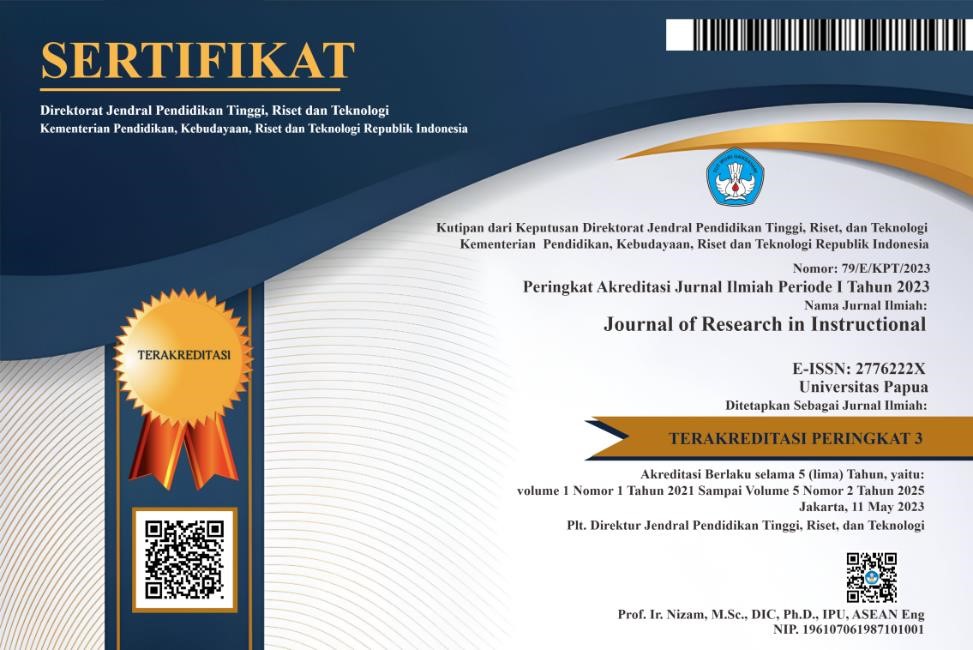Direct and indirect written corrective feedback in learning writing: The students' perception
DOI:
https://doi.org/10.30862/jri.v3i2.250Keywords:
Second language, student perception, written corrective feedbackAbstract
This study was carried out based on the hottest issue regarding the role of direct and indirect written corrective feedback (WCF). The role and use of direct WCF and indirect WCF have been debated issues among second language acquisition and writing researchers. The controversial issue regarding the necessity of feedback started from Truscott’s comment that direct written corrective feedback does not improve students’ writing skills. This research explored the students’ perception of direct WCF and indirect indirect WCF. Qualitative descriptive was applied in this research involving 30 students as the subject. A questionnaire and interview were carried out as the instruments in collecting data. An interactive model that included data collecting, coding, data display, and conclusion or verification was employed for the data analysis. The findings suggested that direct written corrective feedback had a beneficial impact because 99.91% of students said they preferred it.
References
Bimo, W. (2010). Introduction to general psychology. CV Andi.
Bitchener, J., & Ferris, D. R. (2012). Written corrective feedback in second language acquisition and writing. Routledge. https://doi:10.1017/S0261444812000250
Chung, B. (2015). Written corrective feedback: The perception of Korean EFL learners. Journal of Pan-Pacific Association of Applied Linguistics, 19(2), 75–88.
Cohen, L., Manion, L., & Morrison, K. (2017). Research methods in education. Routledge. https://doi.org/10.4324/9781315456539
Danial, H., & Idul, R. (2020). Preferensi peserta didik terhadap umpan balik guru pada kemampuan menulis bahasa inggris di sekolah menengah kawasan Teluk Tomini. Jurnal Kajian Bahasa, Sastra Dan Pengajaran (KIBASP), 4(1), 36–48. https://doi.org/10.31539/kibasp.v4i1.1509
Ene, E., & Kosobucki, V. (2016). Rubrics and corrective feedback in ESL writing: A longitudinal case study of an L2 writer. Assessing Writing, 30, 3–20. https://doi.org/https://doi.org/10.1016/j.asw.2016.06.003
Ferris, D. R., Liu, H., Sinha, A., & Senna, M. (2013). Written corrective feedback for individual L2 writers. Journal of Second Language Writing, 22(3), 307–329. https://doi.org/10.1016/j.jslw.2012.09.009
Ferris, D., & Roberts, B. (2001). Error feedback in L2 writing classes: How explicit does it need to be? Journal of Second Language Writing, 10(3), 161–184. https://doi.org/10.1016/S1060-3743(01)00039-X
Harmer, J. (2007). The practice of English language teaching fourth edition. Malaysia: Pearson Education Limited.
Husain, B., Suhernita, S., Abasa, Z., & Djaguna, F. (2021). Task-based language teaching methods integrated with local wisdom: The impact on students’ writing skills. Journal of Research in Instructional, 1(2), 123–132. https://doi.org/10.30862/jri.v1i2.22
Jalaluddin, I., Yunus, M. M., & Yamat, H. (2011). Improving Malaysian rural learners’ writing skill: A case study. Procedia-Social and Behavioral Sciences, 15, 1845–1851. https://doi.org/10.1016/j.sbspro.2011.04.013
Jamalinesari, A., Rahimi, F., Gowhary, H., & Azizifar, A. (2015). The effects of teacher-written direct vs. indirect feedback on students’ writing. Procedia-Social and Behavioral Sciences, 192, 116–123. https://doi.org/10.1016/j.sbspro.2015.06.018
Kahyalar, E., & Yılmaz, F. (2016). Teachers’ corrective feedback in writing classes: The impact of collaborating with a peer during the editing process on students’ uptake and retention. The Reading Matrix: An International Online Journal, 16(1), 148–160. http://www.readingmatrix.com/files/14-4826614k.pdf
Lewis, M. (2002). Giving feedback in Language Classes. RELC Portfolio Series I. Singapore. Oxford Graphic Printers Pte Ltd.
Miles, M. B., & Huberman, A. M. (1994). Qualitative data analysis: An expanded sourcebook. sage.
Mubarak, M. (2013). Corrective feedback in L2 writing: A Study of Practices and Effectiveness in the Bahrain Context (Publication No. 4129) [Doctoral dissertation, University of Sheffield]. White Rose eTheses Online. https://etheses.whiterose.ac.uk/4129/
Qiong, O. U. (2017). A brief introduction to perception. Studies in Literature and Language, 15(4), 18–28. http://dx.doi.org/10.3968/10055
Rahmawati, S. M. (2017). Direct and indirect corrective feedback on efl students writing skill: A case study in a junior high school in Bandung. In Journal of English and Education 5(1), 64–71. http://ejournal.upi.edu/index.php/L-E/article/view/9904
Sahmadan, S., & Muhamad, S. (2022). The Exploration of Teacher’s Feedback and Students’ Perspective In Learning Writing English Text. International Journal of Education, Information Technology, and Others, 5(5), 7–14. https://doi.org/10.5281/zenodo.7414229
Saragih, N. A., Madya, S., Siregar, R. A., & Saragih, W. (2021). Written corrective feedback: Students’ perception and preferences. International Online Journal of Education and Teaching, 8(2), 676–690. https://iojet.org/index.php/IOJET/article/view/1143
Sherpa, S. Z. (2021). Effects of direct and indirect written corrective feedback on bhutanese learners’ grammatical accuracy over time. LEARN Journal: Language Education and Acquisition Research Network, 14(1), 574–603. https://so04.tci-thaijo.org/index.php/LEARN/article/view/248704
Westmacott, A. (2017). Direct vs. Indirect written corrective feedback: Student perceptions. Íkala, Revista de Lenguaje y Cultura, 22(1), 17–32. https://doi.org/10.17533/udea.ikala.v22n01a02
Zaman, M. M., & Azad, M. A. K. (2012). Feedback in EFL Writing at tertiary level: Teachers’ and Learners’ perceptions. ASA University Review, 6(1). 139–156. https://asaub.edu.bd/data/asaubreview/v6n1sl11.pdf
Zekarias, A. P. (2023). Contributions and controversies of self-assessment to the development of writing skill. Journal of Research in Instructional, 3(1), 13–30. https://doi.org/10.30862/jri.v3i1.94
Downloads
Published
Issue
Section
License
Copyright (c) 2023 Safrudin Sahmadan, Idhar Hasan

This work is licensed under a Creative Commons Attribution-ShareAlike 4.0 International License.






